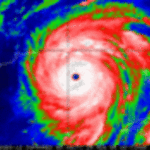In the Middle Ages in the 1300s, black plague killed millions of people throughout Europe. Some estimates place the number at 75 million deaths. It’s hard to imagine one disease killing so many people in a matter of a few years, yet it happened. There have been other pandemics of plague throughout history as well, but never to the extent as in the 1300s. Plague is a bacterial infection generally spread by the bite of a common flea. In the Middle Ages, living conditions were not exactly the cleanest or healthiest. The lack of hygiene and piles of refuse helped to bring rats into the cities. Since the rats thrived very well on all of the trash and food scraps lying around, they reproduced in great numbers and would come into people’s homes searching for more food. The rats, unfortunately, carried fleas with them.
Some of the fleas were infected with the bacterium Yersinia pestis, which was the cause of bubonic plague. Once people began falling ill from plague, it spread quickly among the crowded populations. As plague progresses, it can turn into a respiratory stage, which then is spread through sneezing or coughing. The droplets of moisture coming from the lungs carries the bacteria that has settled in the lungs. Therefore, plague was also spread from person to person, or even from handling the dead and coming into contact with the bacteria. So, is Bubonic plague a pestilence of the past? Hardly. It’s still around today and every few years, a new outbreak is announced.
What can modern people do to protect themselves? People living in squalid conditions are always at risk, but it doesn’t mean people living in clean homes and cities can completely avoid plague. Of course, the cleaner the town or home, the fewer rats and rodents, which means the less likelihood of having flea infestations, but flea carrying rodents can still infiltrate neighborhoods. With cities sprawling out further and further into the wilderness, there are likely to be more incidences of contact with infected rodents. In the United States, there are some ‘hot spots’ where plague has been recorded. These are California, Oregon, Nevada, New Mexico, Colorado and Arizona. Most modern day infections are caused by wild rodents, not common household rats, so hikers, backpackers, campers and families out picnicking in nature must always exercise extreme caution when coming in close proximity to animal burrows or dead rodents. Nobody should ever touch a dead or sick animal. Even with precautions, there are still thousands of cases of plague each year reported by the World Health Organization (WHO).
The symptoms of plague are chills and fever, swollen lymph nodes, stomach pain and cough. When it changes into the infectious pneumonic stage, the patient will have trouble breathing and if they don’t receive treatment, they could die. Even though there are under 50 cases of plague each year in the United States, Americans still need to be very careful when outside or dealing with rodents.



